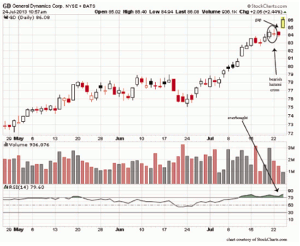In this article, Michael Thomsett of ThomsettOptions.com, provides a detailed analysis of a recent trade, complete with an explanation of the rationale behind his decision to open the trade; and timing of closing the trade.
The trade used is for a recent one on General Dynamics (GD). I sold two AUG 85 calls on July 24, the date earnings were announced. The earnings per share was much higher than expected, at 1.81 versus expected 1.61. As a result, the stock price jumped higher early in the day. Expecting a retreat based on the chart, I sold the calls.
Here’s what caught my eye besides the price jump:
- The bearish harami cross that preceded this move disturbed me, revealing a likely decline to follow soon.
- A price gap was found between the previous day and the earnings announcement day. Gaps often signal a likely reverse and fill, so I was especially interested in what this could mean.
- Momentum signal: finally, RSI was in the “overbought” area—and the fact that it had been there for a while confirmed my expectation that the price would fall. The technical signals plus positive earnings surprise is what led me to this trade.
By the afternoon, my thinking was confirmed. The GD price fell enough so that my two short calls declined to 2.70, down 1.58 from the sale price a few hours earlier. So I entered a “buy to close” order and took the $158 profit, which was 37% in about a half day.
Questions for you:
- Was it wise to close this position in only one day?
- Would you have opened this position at all, considering short call risks in any conditions?
- Are there alternative strategies you would have been more likely to use instead?
- Would you have closed at this point, or perhaps closed only one of the two options?
The question of risk has to be address in trades like this, without fail. Short calls are among the highest of risks because if you are wrong and the price rises, you could face exercise or an expensive outcome. So alternatives should always be considered. Any position a trader opens should include complete awareness of the risk levels, in comparison to individual risk tolerance.
Another issue in trades like this: Why two options? Why not one, or five or even ten? Part of the answer is the amount of cash involved, and in addition, for short positions there is the question of collateral. Uncovered short trades require collateral in the margin account equal to the strike value. In this case, two uncovered 85 calls would require $17,000 in collateral. This trade was done in the virtual portfolio, so I am also motivated by the desire to keep it educational. The number of contracts you select should be based on your personal preference and risk tolerance. Some points about risk worth remembering:
- Multiple contracts reduce the trading costs per option.
- With more than one or two open positions, you can close partially to take profits while letting the remainder ride.
- The decision should be based on risk spreading. In a swing trading program, it makes sense to keep the dollar level about the same among many trades, because you are not going to get 100% profits. Why risk a series of small profits on one reckless large trade?
- The use of short calls is only one example of the strategic possibilities here. You might prefer a hedged position like a spread, strangle, or even a backspread.
The choice of GD is another question worth considering. Just as profits can accumulate quickly in any options trade, so can losses. So it’s a toss-up between opportunity and risk. This is a reality every options trader lives with and cannot avoid.
One reason for focusing on this stock was the earnings surprise. I like to jump in at such moments, because a reversal occurs more often than not.
Are there other stocks that would work as well or better? Yes, there probably are. I like GD due to what I call its “gentle volatility” and overall recent upward trending price. And I’ve been watching the stock for months waiting for this opportunity, which brings up one final point: You are going to have a better result if you invest your time in tracking specific stocks for trades, because you will then be familiar with the volatility and price movement trends.’
By Michael Thomsett of ThomsettOptions.com






















